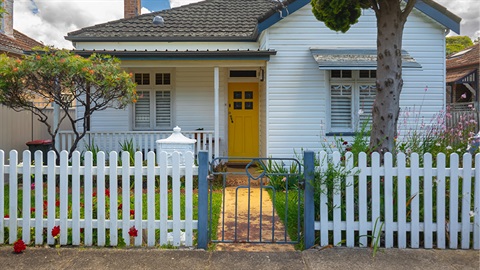Fencing

If you want to build a fence on your property, you may need a building permit. If you've seen a dangerous fence, you can report it to us.
Fencing - do I need a permit?
Different fences may require different permits, depending on the location of your house, and the type of fence that you want to construct.
General guidelines
Front fences
Front fences are considered to be any fence within three metres of a street alignment (like the footpath), including the front section of a dividing boundary fence between you and your neighbour.
If you want to build or replace a front fence on your property, its regulation height will depend on the material you use. You'll need a building permit to build these types of fences:
- Timber or metal front fence higher than 1.5 metres (eg. timber pickets, colorbond sheets)
- Masonry front fence higher than 1.2 metres (eg. brick, rendered concrete, engineered stone)
A building permit can be issued by a Private Building Surveyor (PBS). To find a PBS in your area, search the VBA website.
Front fences on declared roads (RDZ1)
If you live on a declared road then you can have a front fence up to two metres high (with a building permit).
To check if your street is a declared road, you can check VicRoads' declared roads map.
If you have an easement on your property and intend to build the front fence over it, you must obtain a consent to build over easement.
Corner properties
Corner properties have specific requirements for front fences, meaning they can be up to one metre high within nine metres of the point of intersection (the corner boundary edge of your property).
After the nine metres, the front fence can be up to 1.5 metres high.
Front fences higher than the standard height
If you want a higher than standard front fence, you'll need to apply for Council consent. Essentially, you're asking us to approve a design that is not compliant with the Building Regulations 2018.
You'll need to complete an application (known as a Siting Consent or Report and Consent) so that we can make an assessment. It's not guaranteed you'll get approval and it depends largely on how the proposed fence will address:
- the Minister's Guidelines
- neighbourhood character and street amenity
- pedestrian and road safety
- planning permit (if required)
Find out about which documents you need to apply for a Report and Consent. Once you have the correct documents you can apply through eservices.
Not sure whether you need a building permit for your proposed fence?
Call the Building Department to discuss your plans on 03 8470 8899.
Dividing boundary fences
These are fences between adjoining properties, and can be up to two metres high without a building permit, no matter what the material the fence is built from.
Boundary fences are often shared, common property, so you will need to discuss any arrangements directly with your neighbour. If you don't know who your neighbour is you can request this information from us.
If the boundary fence forms part of a spa or swimming pool enclosure, you need a building permit regardless of height or material.
Learn more about swimming pool and spa requirements.
Fencing disputes
Dividing or common boundary fences are generally governed under the Fencing Act 1968. We have no jurisdiction on any common fence issues that don't require a building permit.
If you have a dispute with your neighbour, please contact:
Dangerous fences
Front or side fences facing streets, roads or public spaces must be structurally sound. We'll inspect fences in the following situations:
- when there is a risk of harm to the public or occupants
- dangerous, dilapidated or illegal fences that form part of a swimming pool or spa enclosure. We consider these to be an immediate danger that must be reported.
- brick or masonry fences on a street boundary that are higher than 1.2 metres and built without a building permit.
More information
Building Department
Phone: 03 8470 8899
Email: building@darebin.vic.gov.au